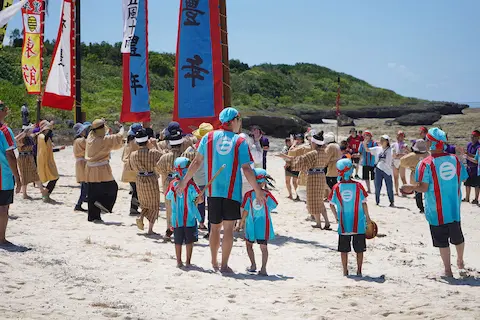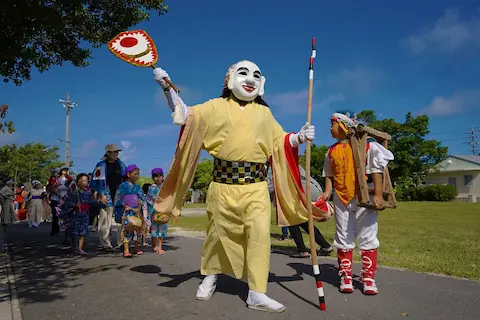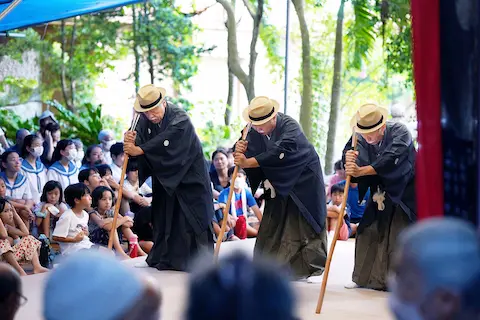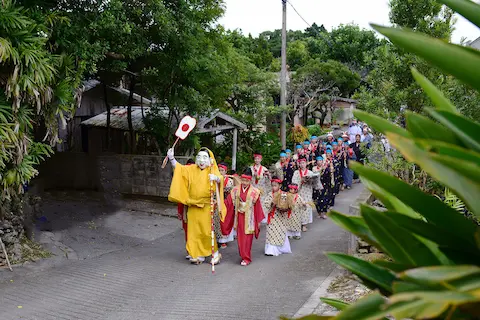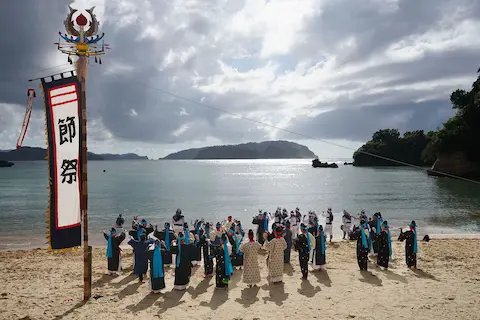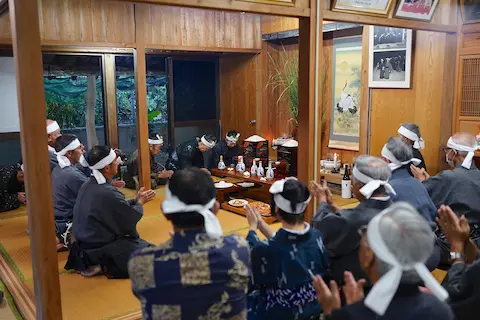Traditional festivals of the islands are a part of daily life.
We express our gratitude for the blessings God gives us.
Photo: Akiko Mizuno/Photographer
(resident of Taketomi Island)
We have compiled this page with the hope that learning about the islands' festivals, will lead to actions that respect the islands.
Please refrain from entering Utaki where island festivals are held, without permission.
Traditional Events of Taketomi Town
-

People pray for and give thanks to a bountiful harvest and good health.
Hounen Festival
The timing varies depending on the region, but it is held when the harvest is complete.
arrow_downward -

During the Bon (Buddhist event) on Hateruma, people pray for good harvest and catches, alongside memorial services for their ancestors.
Mushama
On the 14th day of the 7th month of the lunar calendar, the island hosts a grand procession and stage performances.
arrow_downward -

People thank the Gods for fulfilling our wishes over the past year.
Kitsugan Festival
It is a festival to thank the gods for the prosperity from the past year. Kyougen (theater) and dance performances are offered.
arrow_downward -

People give thanks for the harvest and pray for abundant crops, good health, and prosperity in the new agricultural year.
Shichi Festival
The Shichi Festival in Sonai village, Iriomote lasts for three days. On the second day, there are boat races and various performances.
arrow_downward -

People pray for a successful harvest by sowing seeds.
Tanadui Festival
The Tanadui Festival in Taketomi lasts nine days and features 50 dedicated performances, mainly dances and kyougen (theater) performances.
arrow_downward
People pray for and give thanks to a bountiful harvest and good health.
Hounen Festival
The timing varies depending on the region, but it is held when the harvest is complete.
- Region:
- Taketomi, Kohama, Iriomote (Sonai, Hoshidate, Komi, Funauki), Kuroshima, Hatoma, Aragusuku, Hateruma
- Time:
- June of the lunar calendar
- Photo, Coverage location:
- Kuroshima
Kuroshima's Hounen Festival is unique in being held on the beach. It is a celebration where the islanders send their gratitude and wishes for abundant crops from Niraikanai, a utopia beyond the sea. The festival begins with the Asakui ceremony, in which the men from each village, bow to the Utaki. It continues with the highlight of the festival: the boat race between villages. After the boats return to the beach, the first of the rowers called Uunii, to reach the elders is declared the winner. Afterwards, the villagers form a circle to sing and dance.
Additionally there is a procession let by Miiraku, the God of fertility followed by various performances of offerings. The festivities conclude with Yuuage, where all rowers join forces to lift the boat onto land. It is a festival where you can feel the connection between God, nature and the people.
During the Bon (Buddhist event) on Hateruma, people pray for good harvest and catches, alongside memorial services for their ancestors.
Mushama
On the 14th day of the 7th month of the lunar calendar, the island hosts a grand procession and stage performances.
- Region:
- Hateruma
- Time:
- 14th of 7th month of the lunar calendar
- Photo, Coverage location:
- Hateruma
The five villages are divided into East, Front, and West. When the gong at the community centre rings, the procession led by Miruku, the God of fertility begins. The procession features various dances and performances symbolizing daily agricultural work and fishing practices. The procession moves through the villages towards the community centre. At the community centre yard, staff and drum performances are held in order. The morning ends with the grand ancestor-honouring dance called Ninbucha.
In the afternoon, additional performaces are held. Finally, the procession returns the way it came and brings down the curtain on the festival.
The procession is fun and beautiful and captivates the viewer. It can be seen as a celebration that connects the islanders with their ancestors through the various performances, passed down from one generation to the next.
People thank the Gods for fulfilling our wishes over the past year.
Kitsugan Festival
It is a festival to thank the gods for the prosperity from the past year. Kyougen (theater) and dance performances are offered.
- Region:
- Taketomi, Kohama, Kuroshima, Iriomote (Komi), Hatoma, Aragusuku and others
- Time:
- August - September of lunar calendar
- Photo, Coverage Location:
- Taketomi
The Kitsugan Festival on Taketomi takes place over two days in 8th month of the lunar calendar. On the first day, there is the Yungumai ceremony, where the Kantsukasa, mediators between the gods and people, spend the night with the gods at multiple utaki (a sacred spaces). When dawn falls on the second day, the Kantsukasa visit the 23 utaki on the island and pray. The festival concludes with a series of dedicatory performances. Dances and theater performances called kyougen, are dedicated by each village and performed in the Taketomi dialect. Prayers from the ancestors, wishing for prosperity, will continue to be passed down through festivals.
People give thanks for the harvest and pray for abundant crops, good health, and prosperity in the new agricultural year.
Shichi Festival
The Shichi Festival in Sonai village, Iriomote lasts for three days. On the second day, there are boat races and various performances.
- Region:
- Iriomote (Sonai, Hoshidate, Funauki), Hateruma, Taketomi, Kuroshima
- Time:
- August - September of lunar calendar
- Photo, Coverage location:
- Sonai, Iriomote
The Shichi Festival in Sonai village is held for three days on the 9th month of the lunar calendar. The festival is protected as an Important Intangible Folk Cultural Property from the Japanese government. During the festival, people pray for peace and prosperity on island, abundant crops (especially rice, due to its active cultivation) and good health. For a few weeks, both performers and organizers place the festival at the centre of their lives, and the entire village becomes immersed in the festival. There is an expansive variety of performances, including the Funikui boat race and other performances. The sea acts as a stunning backdrop to the festival with its colourful costumes and flags.
People pray for a successful harvest by sowing seeds.
Tanadui Festival
The Tanadui Festival in Taketomi lasts nine days and features 50 dedicated performances, mainly dances and kyougen (theater) performances.
- Region:
- Taketomi
- Time:
- September-October of the lunar calendar
- Photo, Coverage Location:
- Taketomi
The Tanadui Festival in Taketomi takes place over nine days during the 9th and 10th month of the lunar calendar, praying for the successful growth cycle of seeds. Although agriculture is no longer practised on Taketomi, the festival is still performed as a tradition. The festival is protected as an Important Intangible Folk Cultural Property from the Japanese government. The festival spans about 9 days, during which over 50 performances are dedicated. After the 7th day of performance, Yuukui begins; a ritual which spans overnight where participants visit various households while singing and praying.
The Tanadui Festival, passed down through a long history, reflects the spirit of Utsugumi cherished on Taketomi, where islanders value working hand in hand with eachother. This festival conveys the strength of the community and the importance of tradition to the present day.
One of the best parts of travelling is coming across unique local cultures. Please be respectful of the local customs and remember that festivals are sacred events.










